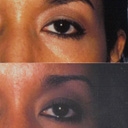Eyelid Surgery in New York
Eyelid surgery is one of the most rewarding procedures we perform in New York. Blepharoplasty, as it’s known in medical circles, requires a modest investment of time and budget by our patients yet it can deliver dramatic rejuvenation results. That’s one reason we enjoy this form of cosmetic surgery so much.
 See Before & After Eyelid Lift Photos
See Before & After Eyelid Lift Photos
Another reason we appreciate the chance to lift upper lids and smooth lower lids for our patients is that we’re highly confident of our skills. When people consult us and express concern that they might suffer complications, we can reassure them that our thousands of satisfied patients and decades of experience mean they are safe with us.
If you believe you look tired all the time, or if you’ve ever been told you look angry or sad when you don’t feel either way, it may be time to find out what eyelid surgery in New York could do for you. Fill out our short contact form and tell us about yourself today!
Our Eyelid Surgery Philosophy
Our New York eyelid surgery patients aren’t the only ones who choose an eyelid lift to refresh their appearance. According to the American Society for Aesthetic Plastic Surgery, blepharoplasty is perennially among the top five procedures for both men and women, with well over 100,000 people choosing it each year.
Patients from all walks of life are glad to find out that Dr. Jacobs’ approach to eyelid surgery is both delicate and conservative. He relies on his extensive training as a plastic surgeon certified by the American Board of Plastic Surgery as well as his extensive experience. You don’t need to worry that your results will appear too tight or even cat-like, nor will your lower lids look sunken or hollow after surgery.
Other advantages of working with Dr. Jacobs include:
His appreciation of male and female differences: Women look best with all redundant eyelid skin removed, creating a bright-eyed look and leaving a smooth surface for makeup. Lower lids for women should also be smooth, with bags, lines, and wrinkles banished completely.
On the other hand, men naturally have a small crease of extra skin on the upper lids. Dr. Jacobs deliberately leaves a very small amount of skin to prevent a too-smooth, feminine appearance. Lower eyelids need not be completely wrinkle-free either—but bags should be removed. For men, a residual small line or wrinkle is perfectly acceptable and perhaps distinguishing.
The mid-facelift: Dr. Jacobs offers a unique procedure called a mid facelift, a kind of extended lower eyelid surgery. Through tiny incisions just below the lower lash line, he can elevate the triangle of cheek tissues below the eyes and down to the corners of the mouth. This procedure can be just what patients need if they are showing early signs of aging; people who would benefit from pulling tissues up instead of to the side of the face.
Blepharoplasty Overview
We use a twilight anesthesia for almost all our New York blepharoplasty patients. You will sleep comfortably throughout the procedure and awaken easily afterward, without the “hangover” of general anesthesia. Eyelid surgery takes about 90 minutes for most people.
For the upper eyelids, Dr. Jacobs makes two carefully measured incisions, placed so that faint scars will be well hidden in a skin crease. Through the incisions, he removes redundant skin that causes the eyelids to droop and any stray fat deposits. The muscles that cause “worry lines” between the brows can be weakened if desired, and Dr. Jacobs can address hollows and eye asymmetry as well.
Dr. Jacobs treats lower lids with small incisions just below the lash line. He can eliminate or reposition fat deposits to smooth bags below the lids, then he pulls up lax skin, removes excess tissue and closes the small wounds. This is when an extended lower eyelid lift, or mid-facelift, can be done, and cheek implants can even be inserted through lower lid incisions to refine the structure of the face.
Risks and Recovery After Blepharoplasty Surgery
The eyes are an extremely delicate area where millimeters make the difference. Blepharoplasty demands great skill and meticulous attention—it’s not a procedure to take chances with. In the hands of a board-certified plastic surgeon like Dr. Jacobs who performs many blepharoplasty procedures annually, you have every reason to expect an excellent result.
General surgery risks include infection, poor wound healing, excessive swelling, and others. Risks specific to blepharoplasty can include dry eyes, blurred vision and abnormal drooping of the eyes. You can play an important role in minimizing risk by following Dr. Jacobs’ instructions to the letter.
Immediately after surgery, you will experience a feeling of tightness and pulling—but pain is rare. During your recovery, you’ll have light swelling and some bruising that will take a while to dissipate. Many people feel ready to go out in public with makeup in about a week; some wait about two weeks. We will give you the information you can use to help heal as soon as possible.
Related Procedures
It is not at all unusual for patients to combine eyelid surgery in New York with other procedures such as the mid facelift. Other cosmetic surgeries that often go hand-in-hand with blepharoplasty are:
- Browlift: Also called a forehead lift, a browlift is a natural complement for blepharoplasty for many patients. Descending forehead skin often contributes to a hooded, tired look around the eyes; for some men and women, having eyelid surgery without a browlift would not be advisable. During your consultation, Dr. Jacobs can show you how to evaluate your own situation and help you make the right decisions.
- Facelift: Many patients undergo a facelift and blepharoplasty at once. Combining these procedures makes sense in terms of both cost and recovery time, and it can be so satisfying to rejuvenate your face from top to bottom.
- Mommy Makeover: While many moms look tired due to the demands of their schedule, some feel their appearance suffers from more than just the lack of rest. Some women who consult us about body and breast procedures choose eyelid surgery and perhaps a facelift to put the final touches on a mommy makeover.
Eyelid Surgery FAQ
Below are just a few of the many questions we answer about blepharoplasty. If you have a question that isn't answered here contact us online or call 212-570-6080 to schedule a personal consultation.
Q: I’m young but have bags under my eyes, should I consider surgery?
The bags you see beneath your lower eyelids are fat deposits, and their appearance tends to be genetically determined. There’s not much you can do about them except to have them surgically removed. If you do not have any lax skin, those fat pockets can be removed through tiny incisions inside your lower lids.
Q: What is transconjunctival eyelid surgery?
Transconjunctival blepharoplasty is performed on the lower lids through small incisions inside the eyelid, leaving no trace of surgery on surface skin. This is the preferred method for most younger patients. When there is excess skin present, a small incision is made under the lashes to facilitate removal of the redundant skin.
Q: I have pronounced tear troughs—how are these treated?
There are two leading ways to improve tear troughs, which run from the inner corner of the lower lid down alongside the nose. For some patients, it makes sense to reposition fat from below the lower lid to fill the troughs through a transconjunctival blepharoplasty. For others, a filler such as Restylane® or JUVÉDERM® is a good choice. Some people benefit from a combination of both approaches.
Q: Will eyelid surgery improve dark circles under my eyes?
Dark patches under the eyes are often due to hereditary hyperpigmentation of the skin. If this is the case for you, a chemical peel may be the best treatment. Sometimes darkness under the lower lids is due to shadows created by fat pockets. In this case, blepharoplasty can certainly help. Dr. Jacobs will evaluate your case and give you his recommendation.
Q: Is laser eyelid surgery better than surgery with a scalpel?
Lasers make incisions just like scalpels—some surgeons prefer one or the other, some use both. One thing plastic surgeons generally agree on: the most important factor in successful cosmetic surgery is the skill of your plastic surgeon. Tools are important, but they’re just tools.
Q: Can I have just the upper or lower lids done?
Yes, you can elect to have either upper or lower lids operated on or both. Dr. Jacobs will examine you and offer his recommendations, but the final decisions are yours to make.
Q: Will insurance pay for eyelid surgery?
Experience with patients seeking eyelid surgery in NY has shown us that insurance companies will not cover the blepharoplasty of the lower lids. This procedure is always considered cosmetic. If you consult an optometrist or ophthalmologist and find that you are suffering vision loss due to upper lid ptosis (sagging), it’s possible your insurance company may cover upper eyelid surgery.
Q: Must I get an eye exam before blepharoplasty?
Yes, in every case we have our patients get an eye exam to check for conditions like glaucoma, excessive dryness and so on. We want to make sure your eyes are healthy and ready for a cosmetic procedure!
Q: How can I avoid complications from blepharoplasty?
Eyelid surgery complications are rare, but it is natural to worry about risks. For one thing, the eyes are so important that the thought of surgery can be anxiety-provoking. In addition, when a disastrous result occurs—such as a patient who can’t close her eyes—it tends to be sensationalized. Plastic surgeons agree that the most important factor in assuring success is to choose your doctor very carefully. Consult more than one board-certified plastic surgeon, perform extensive research and background checks and so on. Once you have found the right plastic surgeon, follow his or her advice exactly and you should experience no problems.
Q: Can BOTOX® help around the eyes?
BOTOX® can do things that surgery cannot do – and vice versa. BOTOX® Cosmetic treats the vertical “worry lines” between the eyebrows and is an excellent treatment for crow’s feet. It can even slightly elevate the tail of the eyebrow. But BOTOX® has no effect on excess skin or fat bags. The use of BOTOX® can be considered a wonderful “finishing touch” for eyelid surgery.








